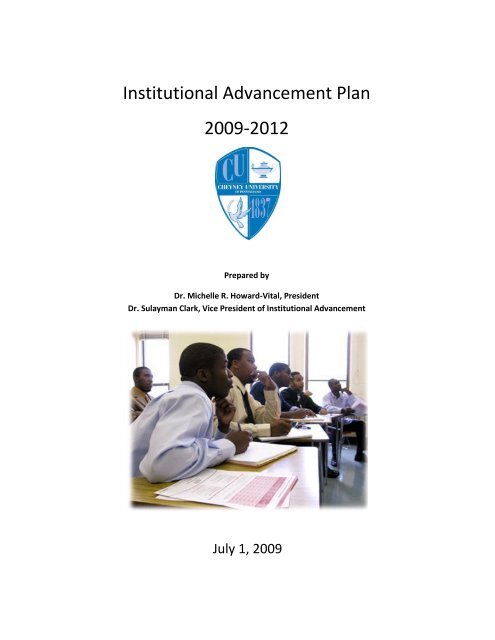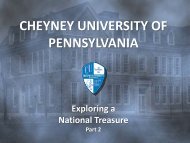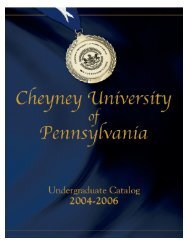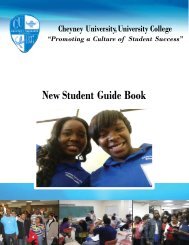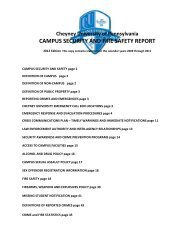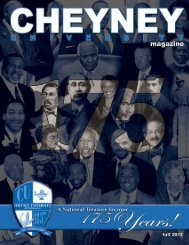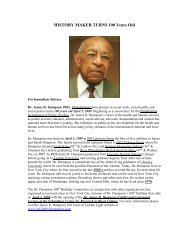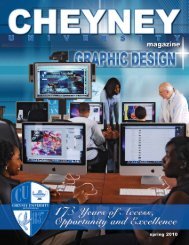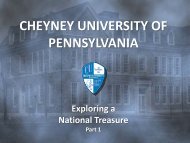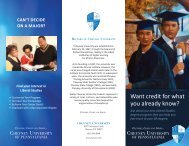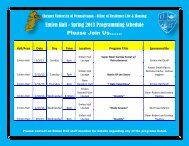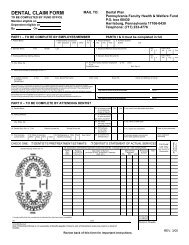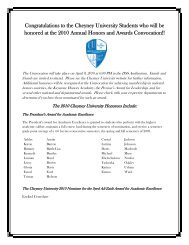Institutional Advancement Plan 2009-2012 - Cheyney University of ...
Institutional Advancement Plan 2009-2012 - Cheyney University of ...
Institutional Advancement Plan 2009-2012 - Cheyney University of ...
You also want an ePaper? Increase the reach of your titles
YUMPU automatically turns print PDFs into web optimized ePapers that Google loves.
<strong>Institutional</strong> <strong>Advancement</strong> <strong>Plan</strong><strong>2009</strong>-<strong>2012</strong>Prepared byDr. Michelle R. Howard-Vital, PresidentDr. Sulayman Clark, Vice President <strong>of</strong> <strong>Institutional</strong> <strong>Advancement</strong>July 1, <strong>2009</strong>
2Table <strong>of</strong> ContentsPage #I. Introduction 4II.A New Strategic Framework for <strong>Institutional</strong> <strong>Advancement</strong>: CriticalSuccess Factors 5III. Baseline Assessment and Analysis 6IV. Fundraising Goals and Objectives for <strong>2009</strong>-<strong>2012</strong> 9V. Prospect Research and Effective Moves Management: The Crux <strong>of</strong> the Matter 14A. Focused Prospect ResearchB. Cultivation Grids and Appointment SchedulesC. Effective Moves ManagementVI. Fundraising Key Components and Critical Success Factors 17A. Implementation <strong>of</strong> an Integrated and Expanded Annual Fund ProgramB. Concerted Emphasis on Major Gifts Acquisitions (e.g., gifts <strong>of</strong> $25,000and above)C. Creation <strong>of</strong> a New Foundation for <strong>Cheyney</strong> <strong>University</strong>D. Enhancing <strong>Institutional</strong> Image and Re-Investment in Vital<strong>Institutional</strong> <strong>Advancement</strong> FunctionsVII. Alumni Relations 36VIII. Government Relations and Sponsored Programs 41
3Page #IX. Public Relations and Marketing 45X. Summary: A Defining Moment in Time 46AppendicesA. Cultivation Grid for State and Federal ProspectsB. Key Legislators: State OfficialsC. Pennsylvania Legislative Black Caucus ListD. PA Key Committed LeadershipE. Key Legislators- Federal OfficialsF. Title III Authorization LetterG. Public Relations and Marketing Approval FormH. Promotion <strong>of</strong> CU Programs <strong>of</strong> DistinctionI. Prospect Grid for Capital ProjectsJ. Prospect Grid for ScholarshipsK. Prospect Grid for General Operating FundsL. Pr<strong>of</strong>itable Public Technology Companies in Greater PhiladelphiaM. Pr<strong>of</strong>itable Banks in Greater PhiladelphiaN. Pr<strong>of</strong>itable Health Care Organizations in Greater PhiladelphiaO. Pr<strong>of</strong>itable Telecommunications Corporations in Greater PhiladelphiaP. Alumni Major Prospects
5and discusses critical success factors that will guide CU’s fundraising efforts over the next threeyears. Sections VII-IX delineates specific strategies and activities for achieving those fundraisinggoals, with particular relevance to alumni relations, government relations and public relations.Implicit in these sections is the need for start-up investment in additional advancement resourcesand practical measures that will render these goals attainable. With these start-up investments,the Office <strong>of</strong> <strong>Institutional</strong> <strong>Advancement</strong> will have a more robust fundraising yield that will fundfuture OIA resource needs.Section X summarizes the plan and notes that the fund-raising challenges ahead.II. A New Strategic Framework for <strong>Institutional</strong> <strong>Advancement</strong>: Critical Success FactorsThis Comprehensive <strong>Institutional</strong> <strong>Advancement</strong> <strong>Plan</strong> is best viewed in the context <strong>of</strong><strong>Cheyney</strong> <strong>University</strong>’s current position in the educational marketplace and its critical need togarner increased private sector and government resources. Throughout most <strong>of</strong> its rich history,<strong>Cheyney</strong> <strong>University</strong> has nurtured a well-earned reputation as the nation’s oldest HBCU and apremier teacher training institution. However, contemporary realities must be confronted headon,if CU is to achieve fiscal solvency and sustained growth in the years ahead.Central to this issue is the need to significantly enhance CU’s institutional image in thegeneral public and the corporate and philanthropic communities. (This need is discussed in fullerdetail in Section VI E.) Enhancing institutional image and reinvesting in vital institutionaladvancement functions are crucial strategies for increasing fundraising potential. The <strong>University</strong>leadership is aware that it needs to reclaim the public trust in its ability to respond to needs <strong>of</strong>the region and to help develop responsible and contributing citizens for the Commonwealth, thenation, and the world.In order to advance <strong>Cheyney</strong> <strong>University</strong>, there must be an expanded community <strong>of</strong>interest that demonstrates effective levels <strong>of</strong> communication and collaboration. Next, theremust be a commitment to change and a new approach to achieving fundraising goals andobjectives based on proven “best practices.” Finally, <strong>Cheyney</strong> <strong>University</strong> must embrace a lessinsular position and link its academic programs and services with specific educational andeconomic needs <strong>of</strong> the southeastern area <strong>of</strong> the Commonwealth and the broader tri-stateDelaware Valley region. This can best be achieved through forging enduring strategicpartnerships based on mutuality <strong>of</strong> purpose and overlapping interests. 11 See <strong>2009</strong> concept paper, The Transformation <strong>of</strong> <strong>Cheyney</strong> <strong>University</strong>: Laying the Foundation for <strong>Institutional</strong> Renewaland Sustainable Growth, Sulayman Clark
6Critical Success FactorsThe pursuit <strong>of</strong> <strong>Cheyney</strong> <strong>University</strong>’s overall advancement and fundraising goals specific“critical success factors” that grow out <strong>of</strong> a careful analysis <strong>of</strong> fundraising results over the pasttwo years, FY 2007-08 and FY 2008-09 and an awareness <strong>of</strong> a nationwide decrease in privatesector support for higher education. In brief, corporate and foundation giving is declining. Thus,during the current economic slump, colleges and universities would be well-advised tocompensate for these declines by focusing on support from individuals <strong>of</strong> wealth, selectedfoundations and new governmental funding opportunities.Moreover, this advancement plan also takes note <strong>of</strong> the important need for afundamental paradigm shift predicated on those four critical success factors.A. Implementation <strong>of</strong> an Integrated and Expanded Annual Fund ProgramB. A Concerted Emphasis on Major Gift Acquisitions (e.g., gifts <strong>of</strong> $25,000 and above)C. Creation <strong>of</strong> a New Foundation for <strong>Cheyney</strong> <strong>University</strong>D. Enhancing <strong>Institutional</strong> Image and Re-Investment in Vital <strong>Advancement</strong> FunctionsSee Section VI for a detailed discussion <strong>of</strong> each.III. Baseline Assessment and Analysis Baseline Assessment: The Impetus for Change and Re-DirectionThe compelling need to improve <strong>Cheyney</strong> <strong>University</strong>’s overall approach to institutionaladvancement has been well-documented by various external consultants and fundraisingpr<strong>of</strong>essionals. 2 In addition, <strong>Cheyney</strong> <strong>University</strong>’s has commissioned three independent publicrelations consulting firm to analyze CU’s institutional image and provide recommendationsregarding how that image might be enhanced. 3 Most recently, the need and impetus for changeis demonstrated in an analysis <strong>of</strong> fundraising results <strong>of</strong> the past two years, FY 2007 and FY 2008.2 For example, see report <strong>of</strong> the Commission on the Continued Vitality <strong>of</strong> <strong>Cheyney</strong> <strong>University</strong> (1993) and apr<strong>of</strong>essional audit <strong>of</strong> the <strong>Institutional</strong> <strong>Advancement</strong> in the OCR Partnership Agreement, (1998).3 See recent reports and recommendations from the Millennium Group, “A Positioning and Reputation ManagementProposal for <strong>Cheyney</strong> <strong>University</strong>” (April, 2008) and “<strong>Cheyney</strong> <strong>University</strong> Branding and Style Guide” (2008)
7AnalysisThese results reflect the fund-raising goals for FY 2007-08 and 2008-09 have been met andexceeded. However, a closer analysis is warranted, particularly in the area <strong>of</strong> private sectorgiving.CategoryGoals2007-2008Actual2007-2008Year to date2008-<strong>2009</strong>Goals2008-<strong>2009</strong>’09 - YTD vs.Goalin $ + (-)’09 – YTD vs.Goal Actualin % + (-)Council <strong>of</strong> Trustees n/a $3,950 $3,350 $5,000 -1,650 67.00%Alumni $ 125,000 $157,532 $130,136 $172,000 -41,864 75.66%Organizations/Churches $75,000 $73,581 $44,191** $80,000 -35,809 55.24%Bequest Expectancies/ $275,000 $230,427 $490,000 $250,000 240,000 196.00%Deferred GiftsBequest Expectancies/ $275,000 $230,427 $490,000 $250,000 240,000 196.00%Deferred GiftsCorporations/Foundations $400,000 $632,649 *$235,400 $700,000 -464,600 33.63%Faculty/Staff $35,000 $13,786 $11,051 $15,000 -3,949 73.67%Individuals n/a $14,095 $39,670 $28,000 11,670 141.68%Vendors n/a $5,750 $10,000 $10,000 0 100.00%Government Grants$4,458,000 $4,926,643 $7,476,982 $6,358,000 1,118,982 117.60%(Please see Notes)Total $5,368,000 $6,058,413 $8,440,780 $7,618,000 822,780 110.80%Private Funds Total - $ 963,798 Public Funds Total - $7,476,982 Year to date is as <strong>of</strong> 6/5/<strong>2009</strong>.*Includes $82,500 from Friends Fiduciary Corporation expected before the end <strong>of</strong> FY ’09.**Includes $34,091 from Family <strong>Plan</strong>ning Council expected before the end <strong>of</strong> FY ’09.NOTES:Government Grants now include the combined Actual, Year to Date and Goal amounts for Sponsored Programs (SP)and Economic & Workforce Development (EWD).
8Private Sector Giving to <strong>Cheyney</strong> <strong>University</strong>(By Constituent Group)A Two Year Comparison2007-2008 2008-<strong>2009</strong>Number <strong>of</strong> Average YTD Number <strong>of</strong> AverageConstituent Groups Actual Donors Gift Actual Donors Gift $ Change % changeCouncil <strong>of</strong> Trustees* $3,950 5 $790 $3,350 4 $837 ($600) -15.19%Alumni 157,532 447 352 130,136 404 $322 -27,396 -17.39%Organizations/Churches 73,581 10 7,383 44,191 12 $3,682 -29,390 -39.94%Bequest Expectancies/DeferredGifts 230,427 2 115,213 490,000 2 $245,000 259,573 112.65%Corporations/Foundations 632,649 15 42,160 235,400 12 $19,616 -397,249 -62.79%Faculty/Staff 13,786 43 341 11,051 33 $335 -2,735 -19.84%Individuals** 14,095 36 421 39,670 47 $844 25,575 181.45%Vendors 5,750 3 1,916 10,000 2 5,000 4,250 73.91%TOTALS $1,131,770 561 $963,798 516-$170,150 -15.03%
9Salient FindingsThe comparison <strong>of</strong> these two years indicates an overall need to increase both the sizeand number <strong>of</strong> private sector gifts across all constituent groups. The number <strong>of</strong> gifts in 2007-2008 and 2008-<strong>2009</strong> is 561 and 516 respectively. Also, while there are only two bequests anddeferred gifts received in each <strong>of</strong> the past two years, they amounted to a significant portion <strong>of</strong>total dollars from individuals. In summary, these data clearly suggest that an emphasis on majorgift acquisition is warranted. Moreover, a focus on bequests and deferred gifts is advisableparticularly when outright giving decreases in a struggling national economy. The practicalimplications for these recent developments are discussed in fuller detail in Sections V-VI thatdelineate how the major gift imperative can be addressed in order to meet <strong>Cheyney</strong><strong>University</strong>’s fundraising goals and objectives over the next three years.IV. Fundraising Goals and Objectives for <strong>2009</strong>-<strong>2012</strong>A. Overview and Needs AssessmentFundraising goals and objectives for the Office <strong>of</strong> <strong>Institutional</strong> <strong>Advancement</strong> emanatefrom CU’s Academic <strong>Plan</strong> (March, <strong>2009</strong>), the president’s vision, and its evolving strategy plan. 4In addition, <strong>Cheyney</strong> <strong>University</strong> will be developing an updated campus-wide master plan thatwill articulate capital projects (i.e., new construction and renovation projects) that are eitherunderway or in the planning phase.<strong>Institutional</strong> priorities fall into five basic categories <strong>of</strong> need:1) Operating Funds – unrestricted dollars that supplement revenues derived from stateappropriations, tuition and fees, etc.2) Capital Projects – restricted funds to support new construction and major renovations.These funds are needed to address various unmet projected costs.3) Scholarship Funds – endowed and non-endowed funds to attract and retainacademically talented and financially needy students.4) Support for three proposed Centers <strong>of</strong> Excellence in the areas <strong>of</strong>:Communications Media and Entertainment ArtsNatural and Applied SciencesTeaching and Learning5) Support for Signature Academic Programs and Evolving Initiatives including but not limitedto:The Keystone Honors AcademyThe “Call Me MISTER” ProgramA Revitalized Teacher Education Program4 <strong>Cheyney</strong> <strong>University</strong>’s strategic plan will be issued in December, <strong>2009</strong>.
10Expanded programming at CU’s Urban Site focusing on the needs <strong>of</strong> adult learnersand non-traditional students who seek the baccalaureate degree and/or careerdevelopment and “re-tooling” programs leading to gainful employment. 5These five categories <strong>of</strong> need are briefly discussed below with reference to specificresource (fundraising) needs over the next three years, <strong>2009</strong>-<strong>2012</strong>1. Operating Funds – Unrestricted funding to support the operational needs <strong>of</strong> CU mustbe increased (see recent two year comparison, (p. 6) in light <strong>of</strong> declining stateappropriations. The challenge is that donor preference favors restricted, rather thanunrestricted, giving. A goal <strong>of</strong> $500,000 is suggested which would derive fromunrestricted private gifts and from indirect cost income that CU is able to obtain viagrants, earmarks and/or contracts.Projected Need: $500,000 62. Capital Projects – funds are currently needed to address shortfalls in ongoing capitalprojects:Humphreys Hall - $1,600,000Marian Anderson Center - $2,900,000Projected Need: $4,500,0003. Scholarship Funds – These funds are needed to attract and retain more diverselytalented students. State appropriations to <strong>Cheyney</strong> <strong>University</strong> are enrollment driveni.e., based on two-year relative growth cycles. Thus, the increased provision <strong>of</strong> thesescholarship funds takes on major significance.Projected Need: $1,000,0004. Support for Proposed Centers <strong>of</strong> Excellence 7Center <strong>of</strong> Excellence in Communications Media andEntertainment Arts (Phase II Implementation)5 <strong>Cheyney</strong> <strong>University</strong> is also seeking a PASSHE authorization to <strong>of</strong>fer a baccalaureate program in the area <strong>of</strong> LiberalStudies and dual certification in Early Childhood/Special Education. The resource needs for the aforementionedwill be projected at a later date in collaboration with the Provost.6 This will be achieved or approximated in part via an integrated and expanded Annual Fund Program.7 The COE in Social and Behavioral Sciences has not yet projected resource needs over the next two years.
11Projected Need:$800,000 in FY<strong>2009</strong>-2010 onlyCenter <strong>of</strong> Excellence in Natural and Applied Sciences(Current Focus in Aquaculture)Projected Need:$200,000 in FY<strong>2009</strong>-2011Combined Projected Needs: $1,000,0005. Support for Signature ProgramsThe Keystone Honors Academy: This program is primarily supported by stateappropriations. (Current state funding for this exceptional program is below the level <strong>of</strong>appropriations cited in the OCR agreement.) An additional $1,000,000 over the course<strong>of</strong> the next three years is needed to attract talented students. Participants in thisprogram boast a graduation rate <strong>of</strong> 82%, well above the national average.Projected Need: $1,000,000“Call Me MISTER” Program 8 : This outstanding teaching training program is in need <strong>of</strong>continuation funding in <strong>2009</strong>-12. An additional $1,000,000 over the course <strong>of</strong> the nextthree years is needed.Projected Need: $1,000,000Combined Signature Programs Needs: $2,000,0008 The “Call Me MISTER” (Mentors Instructing Students Through Effective Role-Modeling) teacherleadership program for minority males is an innovative and progressive approach that effectively produces highlyqualified teachers to not only effect change in classrooms but communities alike. The “Call Me MISTER” programhas created a component for females that addresses the lack <strong>of</strong> minority women in the field <strong>of</strong> STEM (Science,Technology, Mathematics and Science). With these programs, <strong>Cheyney</strong> <strong>University</strong> will again make its mark in thefield <strong>of</strong> higher education and public education across the region." In order to sustain the program another twoyears and increase enrollment, $600,000 will need to be acquired. The funds will ensure the graduation <strong>of</strong> studentsin the program and also be able to bring in cohorts <strong>of</strong> five students per year. The additional funds will also helpsupport in recruiting more staff and resources in order to increase the quality <strong>of</strong> its participants.
12Summary <strong>of</strong> Projected Needsyears.In summary, <strong>Cheyney</strong> <strong>University</strong> must raise an additional $9,000,000 over the next threeSummary <strong>of</strong> NeedsOperating Funds $ 500,000Capital Projects $ 4,500,000Scholarship Funds $ 1,000,000Centers <strong>of</strong> Excellence (2) $ 1,000,000Signature Programs $ 2,000,000TOTAL $ 9,000,000This total is a formidable goal that requires an initial investment in the Office <strong>of</strong><strong>Institutional</strong> <strong>Advancement</strong> to substantially increase the unit’s fundraising yield. CU issomewhat unique in that Sponsored Programs falls within OIA. This is fortuitous because it willrequire a coordinated effort to enhance both private giving and public support (i.e. grants,earmarks and contracts) in order to succeed. A private giving sub-goal <strong>of</strong> $3.5 million and apublic funding sub-goal <strong>of</strong> $5.5 million are suggested.With respect to public funding, the emphasis <strong>of</strong> the overall $9 million goal on academicprograms and student-centered capital needs suggests a high potential for support from grants,earmarks and contracts. Formulating the grants equivalent <strong>of</strong> the private gifts chart presentedabove is a bit problematic since gift size emanates from the requestor, along with negotiationfrom the donor, whereas grant size is largely grantor-driven. The following chart provides anoverall framework for enhanced public funding <strong>of</strong> 5.5 million (61% <strong>of</strong> the $9 millioncomprehensive goal). Please note that even with the best strategic selection and preparation<strong>of</strong> grants to pursue, at least five grants must be submitted for each grant successfully funded.Table for Public Grants, Earmarks and Contracts - Cumulative Sub-Goal <strong>of</strong> $5,500,000Level Grant Level Grants Required Level Subtotal % <strong>of</strong> the Goal Cumulative TotalLevel 1 $1,000,000 1 $1,000,000 18.18% $1,000,000Level 2 $500,000 2 $1,000,000 18.18% $2,000,000Level 3 $250,000 6 $1,500,000 27.27% $3,500,000Level 4 $100,000 9 $900,000 16.36% $4,400,000Level 5 $50,000 10 $500,000 9.09% $4,900,000Level 6 $25,000 16 $400,000 7.27% $5,300,000Level 7 $10,000 20 $200,000 3.64% $5,500,000TOTAL 64 $5,500,000 100.00%
13With respect to private giving, a sub-goal <strong>of</strong> $3.5 million translates to roughly 39% <strong>of</strong> the$9 million comprehensive goal. Implicit in this $3.5 million goal is an increase in both thenumber and size <strong>of</strong> gifts to support these categories <strong>of</strong> need and a required focus on “majorgifts” <strong>of</strong> $25,000 and above. As the gift table below indicates, the acquisition <strong>of</strong> major gifts isessential to CU’s overall fundraising outcomes. Moreover, this depiction stands in stark contrastto recent (baseline) assessments relative to the number and average size <strong>of</strong> private sector gifts(see p. 7)Gift Table for Private Gifts Cumulative Sub-Goal <strong>of</strong> $3,500,000LevelGift LevelGiftsRequiredProspectsRequired Level Subtotal % <strong>of</strong> the GoalCumulativeTotalLevel 1 $1,000,000 1 20 $1,000,000 28.57% $1,000,000Level 2 $500,000 1 20 $500,000 14.29% $1,500,000Level 3 $250,000 2 40 $500,000 14.29% $2,000,000Level 4 $100,000 4 80 $400,000 11.43% $2,400,000Level 5 $50,000 6 120 $300,000 8.57% $2,700,000Level 6 $25,000 14 280 $350,000 10.00% $3,050,000Level 7 $10,000 30 300 $300,000 8.57% $3,350,000Level 8 $1,000 150 1,500 $150,000 4.29% $3,500,000TOTAL 208 2,360 $3,500,000 100.00%AnalysisThe private gift table demonstrates the critical importance <strong>of</strong> major gifts <strong>of</strong> $25,000 andabove. Specifically, CU would need to secure no less that 28 gifts from Levels 1-6 in order toachieve this aggressive cumulative goal <strong>of</strong> $3,500,000. Furthermore, in order to achieve thisgoal, 208 donors must emerge from 2,360 viable prospects. These prospects would beproperly identified, screened, cultivated and solicited adhering to a disciplined and coordinatedapproach to moves management. This is a major undertaking, particularly given the currentstaffing and resources <strong>of</strong> the Office <strong>of</strong> <strong>Institutional</strong> <strong>Advancement</strong>. An expanded community <strong>of</strong>interest comprised <strong>of</strong> trustees, volunteers, peer solicitors must collaborate with <strong>Cheyney</strong><strong>University</strong> personnel and collectively “manage” this prospect pool “by adhering to provenstrategies traditionally referred to as prospects research and “moves management.”Importance <strong>of</strong> Leadership GiftsThe gift table presented above reflects a need for at least 8 gifts <strong>of</strong> $100,000 and above(Levels 1-4). In the context <strong>of</strong> <strong>Cheyney</strong> <strong>University</strong>’s fundraising goal, gifts at these levels arereferred to as “leadership gifts.” Such gifts serve an important dual purpose. First, gifts <strong>of</strong> this
14magnitude represent 69% <strong>of</strong> the overall fundraising goal. Second, they have a catalytic effect.As leadership gifts are committed and secured, confidence in <strong>Cheyney</strong> <strong>University</strong> is elevated.The gradual accumulation <strong>of</strong> these gifts sends a clear signal throughout the broaderphilanthropic community suggesting that <strong>Cheyney</strong> <strong>University</strong> is indeed an institution <strong>of</strong> valueand one whose vital mission should be supported. This catalytic effect typically reverberatesas such gifts are widely publicized and acknowledged. 9 In effect they create a wholesomeclimate <strong>of</strong> investment that welcomes gifts from other quarters (e.g. alumni and friends <strong>of</strong>higher education).Such gifts will be aggressively pursued over the next three years and beyond;particularly as <strong>Cheyney</strong> <strong>University</strong> considers the advisability and feasibility <strong>of</strong> a capitalcampaign. In <strong>2012</strong>, <strong>Cheyney</strong> <strong>University</strong> will mark its 175 th anniversary as the nation’s oldesthistorically black college or university. This milestone may constitute an ideal time to launchsuch a campaign, predicated on acquisitions <strong>of</strong> leadership gifts over the next three years, <strong>2009</strong>-<strong>2012</strong>.V. Prospect Research and Effective Moves Management: The Crux <strong>of</strong> the MatterFocused Prospect ResearchThe aggressive pursuit <strong>of</strong> CU’s $9,000,000 goal will require a concerted and sustainedeffort on the part <strong>of</strong> an expanded “community <strong>of</strong> interest” dedicated to identifying andcultivating an increased number <strong>of</strong> funding prospects.CU’s process <strong>of</strong> fundraising will be guided by aggressive prospect research whichenables it to identify viable prospects that are worthy <strong>of</strong> cultivation and solicitation.“Worthiness” is determined by the prospect’s 1) capacity to give, 2) his/her motivation to giveand 3) prior or recent giving to education and related causes. Subsequently, the cultivationprocess leading to solicitation (the actual ask) requires efficient and artful “movesmanagement” that is the responsibility <strong>of</strong> designated administrators, OIA staff, Trustees and/orvolunteer peer solicitors.OIA’s prospect researcher collects research on individuals who might have capacity orpropensity to support CU. This person also researches names that come to us from bothinternal and external sources and additionally assists us in carefully researching our existingfiles and database <strong>of</strong> annual and planned giving donors. Additionally, OIA utilizes mediasources, on-line search engines, directories and referral sources such as pr<strong>of</strong>essional advisors,key alumni, faculty, Office <strong>of</strong> the President, department chairs, and so forth.9 <strong>Cheyney</strong> <strong>University</strong> may consider naming opportunities as an incentive for leadership gifts. Named scholarshipfunds and individual naming rights on various buildings and facilities should be negotiated with prospectivedonors.
15Cultivation GridsThese prospect research activities enable the formulation <strong>of</strong> cultivation grids thatcapture salient information and organize “next steps” in the cultivation process. These gridsinclude:Name <strong>of</strong> EntityContact informationProspects funding interestsRecommended AskDeadlines for proposal submissionThese grids will also enable the Office <strong>of</strong> <strong>Institutional</strong> <strong>Advancement</strong> staff and othermoves managers to focus attention, organize proposal development and meet importantsubmission deadlines over the course <strong>of</strong> a given funding cycle. Appendix A and Appendices J-Pprovide cultivation grids and/or partial listings <strong>of</strong> prospects to be cultivated in FY <strong>2009</strong>-2010 (inkeeping with the institutional categories <strong>of</strong> need reflected in Section IV).Letters <strong>of</strong> Inquiry and Preliminary ProposalsMore <strong>of</strong>ten than not, corporations and foundations require the submission <strong>of</strong> a letter <strong>of</strong>inquiry or a preliminary proposal (1-2 pages) as a prelude to a formal appointment. Based onthis information, they will determine if CU’s interest and needs fall within the scope <strong>of</strong> theirfunding priorities and strategic business interests. These letters <strong>of</strong> inquiry and preliminaryproposals are being developed now, in preparation for an accelerated schedule <strong>of</strong>corporate/foundations exploratory appointments beginning in the Fall <strong>2009</strong>. Also, thesepreliminary documents typically ignite the interests <strong>of</strong> individual donor prospects who want tosupport <strong>Cheyney</strong> <strong>University</strong> in meaningful ways. Preliminary proposals <strong>of</strong> the followingcategories <strong>of</strong> need are currently being developed by the Vice President for <strong>Institutional</strong><strong>Advancement</strong> (VPIA). Additionally, to pave the way, <strong>Cheyney</strong> <strong>University</strong> is continuing to tell itsgood story through publications and other media venues.Operating FundsScholarship (Funds) (endowed and non-endowed)The “Call Me MISTER” ProgramThe Keystone Honors ProgramCapital Projects – <strong>of</strong>fering naming opportunities to major donorsCenters <strong>of</strong> Excellence (2): Communication Media and Entertainment Arts andNatural and Applied Sciences (Aquaculture)
16Effective Moves ManagementFundraising is by nature, and is at its best, a collective undertaking requiring high levels<strong>of</strong> communication and collaboration. Using this process, designated moves managers willadhere to the time-tested maxim that fundraising requires the right person, to ask for the rightamount, at the right time. Accordingly, <strong>Cheyney</strong> <strong>University</strong>’s process for identifying,cultivating and soliciting viable prospects will unfold according to the following approach tomoves management.Step 1: Generate detailed prospect pr<strong>of</strong>ile (conducted by alumnus, Trustee, Volunteer or OIAstaff).Step 2: Referent or friend makes initial contact with appropriate (verified) contact person viatelephone or e-mail. Referent conveys that information to OIA immediately.Step 3: Typically, corporations and foundations will first ask for a “letter <strong>of</strong> interest” or what issometimes called a “preliminary proposal". A preliminary proposal and/or letter <strong>of</strong> inquiry (apreliminary proposal template should have already been developed at this point.Step 4: That prospect is then assigned to the OIA, the Vice President for <strong>Institutional</strong><strong>Advancement</strong>, the President, a Trustee, peer solicitor or an alumnus as appropriate forsubsequent moves management.Step 5: An exploratory meeting is scheduled with prospect at his/her <strong>of</strong>fice or on campus (asappropriate).Step 6: A contact report is generated along with notes to file regarding the meeting, proposedcapture strategy, all pertinent data and next steps. (Prepared by the moves manager andsubmitted via phone or e-mail to OIA).Step 7: A deadline for submission is established and/or a self-imposed submission deadline isdetermined.Step 8: A proposal or solicitation is submitted on time (managed by Vice President for<strong>Institutional</strong> <strong>Advancement</strong>).Step 9: Moves manager confirms receipt <strong>of</strong> proposal and <strong>of</strong>fers additional information ifneeded. (two weeks after submission date)Step 10: Moves manager is available for follow-up communications as required.In all instances, major gifts can be payable over a one to three year period at the donor’sdiscretion. These gifts will be given the highest possible recognition and visibility.
17SummaryIn summary, this focused prospect research and subsequent moves management forman integral process leading to improved fundraising results. This process will be coordinatedand managed by the VPIA in close collaboration with the President. The President and VicePresident will meet weekly (at a minimum) to review relative progress along these lines.Ongoing prospect research is essential to the scheduling <strong>of</strong> solicitation visits (on-campus and inthe field), making appropriate travel arrangements and preparing clear and compelling asks in atimely manner consistent with submission deadlines and funding cycles.VI. Fundraising Programs, Strategies and Activities: CU Critical Success FactorsThe aforementioned (two-year) baseline assessment, coupled with the magnitude <strong>of</strong><strong>Cheyney</strong> <strong>University</strong>’s resource needs provide a clear impetus for substantive change at <strong>Cheyney</strong><strong>University</strong> regarding how to attract needed resources. In the coming years, <strong>Cheyney</strong> <strong>University</strong>is committed to approaching fundraising as a shared responsibility and a coordinated effortthat include all internal managers (vice presidents, deans and directors) and external advisors(Trustees, advisors, and so forth). A business as usual approach is being discarded. As such, thefollowing strategies will be adopted as critical success factors that will largely determine therealization <strong>of</strong> enhanced fundraising outcomes.A. Implementation <strong>of</strong> an Integrated and Expanded Annual Fund ProgramB. Concerted Emphasis on Major Gifts Acquisitions (e.g., gifts <strong>of</strong> $25,000 and above)C. Creation <strong>of</strong> a New Foundation for <strong>Cheyney</strong> <strong>University</strong>D. Re-Investment in Support <strong>of</strong> Vital <strong>Institutional</strong> <strong>Advancement</strong> FunctionsA. Implementation <strong>of</strong> an Integrated and Expanded Annual Fund Program: EstablishingCyclical Patterns <strong>of</strong> GivingEstablishing Cyclical Patterns <strong>of</strong> GivingBeginning in Fall <strong>2009</strong>, the Annual Fund Program with be a shared responsibilitydispersed throughout the OIA (and involving leaders in other divisions). In previous years, theAnnual Fund Program has focused solely on alumni who currently constitute over 95% <strong>of</strong> theannual fund’s direct mail database. With the need to increase revenue, <strong>Institutional</strong><strong>Advancement</strong> recommends an expanded Annual Fund initiative to include the cultivation andsolicitation from the following segments in an effort to establish cyclical patterns <strong>of</strong> giving tothe CU. The objective here is to reach out to non-alumni, constituent groups as well andencourage them to build <strong>Cheyney</strong> <strong>University</strong> into their annual contribution cycles or household
18budgets. All <strong>Cheyney</strong> <strong>University</strong> community members will be informed <strong>of</strong> this approach andencouraged to help develop strategic relationships to increase Annual Giving.* Faculty and Staff (current and retired)* Individuals (non-alumni)*Parents*Organizations*Churches* Regional Corporations and Foundations* Local businesses*Vendors*Campus recruitersAnnual Fund Goals: <strong>2009</strong>-<strong>2012</strong>Measurable Outcomes for the new integrated and expanded annual fund program areas follows:1. Increase alumni participation in annual giving from 5% to at least 15% over the nextthree years (with a long term goal <strong>of</strong> increasing alumni participation to 20%).2. Increase proportional non-alumni participation to the annual fund to at least 30% overthe next three years3. Increase COT participation in the annual fund to 100%4. Increase annual on-line giving to a least 100 participants in FY <strong>2009</strong>-2010 and byincrements <strong>of</strong> 100 in each <strong>of</strong> the subsequent two yearsThese goals will be pursued through the following means:Direct Mail and Target MarketingTwo direct mailings will be conducted in the fall and spring <strong>of</strong> the next three yearstargeting the following segments:AlumniFaculty & StaffRetired Faculty & StaffCouncil <strong>of</strong> Trustees
19ParentsFriendsChurchesVendorsLocal businessesCampus recruitersSpecial Segmented MailingsTwo special segment mailings will target lapsed donors (LYBUNTS and SYBUNTS),reunion year alumni and planned giving prospects. Outreach to young alumni will beconducted on-line and through special mail segments.Senior Class GiftThe Alumni Relations Office and student leadership will consult over the course <strong>of</strong> theacademic year and develop messages, activities and publicity for the senior class gift in <strong>2009</strong>-2010.Payroll DeductionThe OIA will work with the <strong>Cheyney</strong> <strong>University</strong> Human Resources Office to receive andmaintain updated data on staff and to create greater flexibility in designating gifts throughpayroll deduction.Board GivingThe OIA will work the VPIA and the Chairman <strong>of</strong> the <strong>University</strong> Relations Committee toask board members to sign fundraising letters to their peers asking for annual support for CU.PhonathonsFall and Spring phonathons will be conducted during FY <strong>2009</strong>- 2010 targeting lapseddonors, young alumni and alumni with no giving history. During the phonathon, volunteerstudent callers will reach out to alumni to ask them to support <strong>Cheyney</strong>.On-line GivingThe OIA will work with the Public Relations Officer to develop a marketing plan to getthe word out that CU has a safe and reliable online giving capacity. Two special appealstargeting young alumni will be sent electronically to recent graduates during FY <strong>2009</strong>-2010.The objective here is increase annual fund giving by younger alumni (graduates 1985-<strong>2009</strong>) byencouraging them to give at minimum levels ($10-$50 a year) and gradually increase theirgiving over time.
20The OIA will continue to obtain e-mail addresses during the course <strong>of</strong> 2010 in an effortto take a fundamental step toward the development <strong>of</strong> an e-philanthropy database at <strong>Cheyney</strong>.Currently, only 7% <strong>of</strong> the database represents good e-mail addresses. During Fiscal Year <strong>2009</strong>-2010 all response cards will ask for e-mail address as well as other updated information. (e.g.addresses and telephone number changes).Events and Alumni Chapter MeetingsIn an effort to reach out to alumni in new and more significant ways, the OIA willcollaborate with the Office <strong>of</strong> Alumni Relations to plan and coordinate regional events in citieswhere <strong>Cheyney</strong> has at least 20 alumni. The Director <strong>of</strong> Alumni Relations will use these eventsto: 1) inform alumni about CU’s strategic directions, resource needs, student and facultyachievements, etc. 2) seek their support for a $1 million alumni giving goal for <strong>2009</strong>-<strong>2012</strong> and 3)identify, cultivate and “enlist” alumni as major gift prospects and peer solutions. The Alumnidirector will also attend scheduled alumni chapter meetings.Acknowledgement and Donor RecognitionAll gifts will be acknowledged by an <strong>of</strong>ficial receipt and thank you letter. All donors,regardless <strong>of</strong> the size <strong>of</strong> their gift, will receive a personal acknowledgment letter signed by thePresident.Donors who increase their support over last year’s gift to the annual fund will receive, inaddition to a formal acknowledgement, a hand-written note thanking them for their increasedsupport.New donors will receive a new donor welcome letter designed to affirm the new donorand welcome them to the <strong>Cheyney</strong> giving community. An <strong>of</strong>ficial acknowledgement letter andreceipt containing strong donor affirmation content will be sent shortly thereafter. This letterwill be signed by the President.Phonathon pledges will be acknowledged in writing immediately after the pledge ismade via a handwritten note from the student caller who took the pledge. When pledges arefulfilled, a formal acknowledgment/receipt will be sent. Individuals who pledge duringphonathon but do not fulfill their commitment will receive pledge reminder letters and a phonecall. Unfulfilled pledges will be written <strong>of</strong>f at the end <strong>of</strong> the year.Gifts made in memory <strong>of</strong> (or) in honor <strong>of</strong> people will receive a special acknowledgementletter signed by the president or the VPIA. Families <strong>of</strong> the deceased (or) people who have beenhonored will be notified that a gift has been made in their honor/memory. All new andrenewing annual fund donors (unless otherwise advised) will be noted in the Honor Roll <strong>of</strong>Donors published at the end <strong>of</strong> each fiscal year.
21B. Emphasis on Major Gift AcquisitionsThe aforementioned baseline data clearly indicate a need to focus on major giftacquisition to better meet the CU’s resource needs. Specifically a decided outreach toindividuals <strong>of</strong> wealth, private foundations and selected (pr<strong>of</strong>itable) corporations is needed.<strong>Cheyney</strong> <strong>University</strong>’s major gift thrust will be coordinated and led by the VPIA, working inclose collaboration with the President and the Director <strong>of</strong> Major Gifts and <strong>Plan</strong>ned Giving.Additionally, all members <strong>of</strong> the <strong>Cheyney</strong> <strong>University</strong> leadership team will be expected toparticipate in identifying prospects for major gifts. The President and VPIA will focus theirefforts on cultivating “high end” prospects that have the capacity to make planned or outrightgifts <strong>of</strong> $50,000 and above (consistent with the aforementioned tables. The new Director <strong>of</strong>Major Gifts and <strong>Plan</strong>ned Giving (DMG for short) will focus on a broad array <strong>of</strong> “lower-end”prospects with the capacity to give in the $25,000-$50,000 range.In particular, the DMG will utilize the following means to execute a new Major GiftProgram that does not currently exist. It should be noted that the DMG will be responsible fordeveloping a detailed plan <strong>of</strong> action in the Fall <strong>2009</strong> that focuses on ways to promote plannedgiving options. During the current economic slump, these planned giving options will be mostfavorable to prospective donors, excluding retired alumni and those living on a fixed income.The identification <strong>of</strong> major gift prospects will be achieved through extensive prospectresearch and leads forwarded to and provided by the President, Vice President for <strong>Institutional</strong><strong>Advancement</strong>, deans and directors, our Trustees, volunteer solicitors and the OIA. The majorgift cultivation and solicitation process is outlined below.Alumni Major Gifts CultivationWealth screening research conducted in FY’08 has uncovered 117 alumni prospects thathave capacity to make a gift in the $10,000 plus gift range. During FY <strong>2009</strong>-2010, theseprospects will be contacted for one-on-one meetings with OIA staff to determine donorinterests and perspectives on the CU. As appropriate, follow-up meetings will be scheduledwith Dr. Vital. These major prospects will also be targeted to receive a quarterly letter from thePresident and invitations to special events and activities.The <strong>Cheyney</strong> Magazine will also be used to promote the major gift by informing alumniand friends <strong>of</strong> “ways to give” and describing planned giving options. Also, the <strong>Cheyney</strong>Magazine and website will be utilized to highlight the contributions <strong>of</strong> major gift donors andgive such gifts maximum public visibility.
22Charitable Gift Annuity ProgramBeginning in the Fall <strong>2009</strong>, the OIA will market a recently developed and approvedCharitable Gift Annuity Program established at the Philadelphia Foundation to benefitscholarships for students at CU. The Charitable Gift Annuity is a simple and convenient way tomake a generous gift to CU while providing an income stream for the donor that is fixed,regardless <strong>of</strong> market conditions. In exchange for a charitable gift <strong>of</strong> $10,000 or more, donorswill receive a fixed stream <strong>of</strong> income for life (or the lifetimes <strong>of</strong> up to two people), backed bythe unrestricted assets <strong>of</strong> The Philadelphia Foundation.President’s Fund for ExcellenceA new initiative to recognize top donors to CU will be launched in FY <strong>2009</strong>-2010. ThePresident’s Fund for Excellence will be marketed to prospects that have the capacity to make agift at the $1,000 + gift level. These prospects will receive a targeted appeal in the fall.President’s Fund for Excellence donors will be recognized on the CU website, in CU Magazine,and in the Annual Report. These donors will also receive quarterly updates about activities(from the president) and invitations to CU events and activities.<strong>Plan</strong>ned Giving<strong>Cheyney</strong> <strong>University</strong> will revitalize its planned giving thrust and accelerate its efforts toidentify, educate, cultivate, and solicit planned giving prospects. As gifts are secured, the newDirector <strong>of</strong> Major Gifts and <strong>Plan</strong>ned Giving will maintain relationships with and steward existingdonors and secure new planned gifts from carefully screened alumni and wealthy individualsinterested in establishing legacy gifts (e.g., wills, estates, insurance policies, etc.)The <strong>Plan</strong>ned Giving thrust will operate as an integral part <strong>of</strong> the Office <strong>of</strong> <strong>Institutional</strong><strong>Advancement</strong> <strong>of</strong> <strong>Cheyney</strong> <strong>University</strong>. A fully developed planned giving program will beimplemented, and it will function to identify, educate, cultivate, and solicit planned givingprospects. Securing planned gifts and stewardship <strong>of</strong> existing donors in support <strong>of</strong> the longtermmission <strong>of</strong> <strong>Cheyney</strong> <strong>University</strong> is the primary focus <strong>of</strong> the <strong>Plan</strong>ned Giving Program.Prospect IdentificationThe identification <strong>of</strong> prospects starts the process and is critical to successfulaccomplishment <strong>of</strong> each <strong>of</strong> the next successive steps (moves management). All <strong>University</strong>leaders are expected to contribute to this process. Identification will be achieved through thefollowing means.
23Raisers Edge DatabaseOIA staff will mine its donor/friend/alumni database for prospects using search criteriabased on: consecutive years giving history, cumulative gifts, and demographic data. Studieshave shown that consecutive years’ giving is the leading indicator <strong>of</strong> planned giving propensity.Alumni AffairsStaff in the Alumni Affairs Office maintains relationships and regular contact with alumniand understand the leadership <strong>of</strong> the clubs, the cities, and the people, thereby supplying thegreatest source <strong>of</strong> personal information and background information to the appropriate personat the <strong>University</strong>. Successful identification <strong>of</strong> prospects from within CU’s alumni pool willdepend largely on working with the alumni affairs staff to help identify people to engage.Prospect Research StaffThe OIA prospect researcher will be utilized to provide background research onindividuals who might have capacity or propensity to support <strong>Cheyney</strong> <strong>University</strong>. This personwill help research names that come to us from both internal (vice presidents, deans, directors)and external sources and additionally assist us in carefully researching our existing files anddatabase <strong>of</strong> annual and major gift donors for potential planned giving prospects. Additionally,we will utilize media sources, wealth indicators, and field research to identify prospects,including the development <strong>of</strong> centers <strong>of</strong> influence (cultivation and education <strong>of</strong> referral sourcessuch as pr<strong>of</strong>essional advisors, key alumni, faculty, Office <strong>of</strong> the President, department chairs,etc.).Harris DirectoryOIA will review this alumni publication for indicators <strong>of</strong> capacity or propensity, andcoordinate this information with that gathered from alumni affairs, Raisers Edge database, andfield research.Field ResearchField research includes introductory communication to gauge interest and internal stafffeedback on contacts or interest shown. This also includes the use <strong>of</strong> self-identification forms.Website Marketing (General)<strong>Cheyney</strong> <strong>University</strong> will utilize direct mail, mail inserts and collateral publications todrive people to our education website on <strong>Plan</strong>ned Giving. We will send out our monthly donornewsletter and twice-monthly advisor newsletter by e-mail to educate and inform. We willeducate people on how to use our website at presentations and meetings, and provide as a
24resource for staff to refer people to. Through rotation <strong>of</strong> editorial and educational content on aregular basis, we will provide attractive and beneficial means <strong>of</strong> education. The OIAcomponents <strong>of</strong> the CU website will be completely revamped and available for posting bySeptember 1, <strong>2009</strong>. On-line giving will be featured on the <strong>University</strong>’s home page.MailingsTargeted mailings describing planned giving methods and strategies will be sent on aquarterly basis to alumni and friends. Timely topic mailings <strong>of</strong> noteworthy tax laws, articles <strong>of</strong>interest or other pertinent news will be sent on an as-needed basis. We will also mail to alumniand friends in advance <strong>of</strong> travel to alumni club or city.Presentation/SeminarsThe OIA will conduct educational seminars and presentations at President’s Cabinetmeetings, dean’s meetings, alumni gathering and three times per year on a local basis or asneeded. The staff will also provide educational presentations for campus-based alumni events,when appropriate.Website Marketing and Publications and BrochuresAs stated earlier, <strong>Cheyney</strong> <strong>University</strong> is planning to aggressively market planned givingthrough a re-designed and expanded website. Utilizing direct mail, mail inserts and collateralpublications, CU intends to steer people to a website link on <strong>Plan</strong>ned Giving. We will send outour monthly donor newsletter and twice-monthly advisor newsletter by e-mail to educate andinform. We will educate people on how to use our website at presentations and meetings, andprovide as a resource for staff to refer people to. Through rotation <strong>of</strong> editorial and educationalcontent on a regular basis, we will provide attractive and beneficial means <strong>of</strong> education.Also, CU utilizes a variety <strong>of</strong> printed material to educate our audience. <strong>Plan</strong>ningStrategies is an introductory piece that outlines various types <strong>of</strong> planned gifts and theirbenefits. This piece is to be used as a general handout or included in introductory mailings.Ways to Give is a more advanced and in-depth booklet on various types <strong>of</strong> planned gifts that isto be used as a leave behind piece at presentations/seminars or as a follow-up to individualsafter more qualification <strong>of</strong> interest. Additionally, topic specific brochures on giving throughyour will, life insurance, securities, and gift annuities will be used as follow-up pieces to directmail or targeted, topical mailing initiatives. Targeted mailings describing planned givingmethods and strategies will be sent on a quarterly basis to alumni and friends. Timely topicmailings <strong>of</strong> noteworthy tax laws, articles <strong>of</strong> interest or other pertinent news will be sent on anas-needed basis.
25Outreach to the Pr<strong>of</strong>essional Athletes and the Arts and Entertainment CommunityThe OIA along with the Vice President for <strong>Institutional</strong> <strong>Advancement</strong>, President, andDirector <strong>of</strong> Athletics, and others as appropriate will also cultivate sports figures and wealthycelebrities in the local and national arts and entertainment community who are in a position tosupport <strong>Cheyney</strong> <strong>University</strong>’s vital mission through planned and outright gifts. Philadelphia ishome to a concentrated number <strong>of</strong> musical artists and high-visibility executives in theentertainment industry. These area individuals <strong>of</strong> means may also be individuals withimmediate tax-incentives industry. We will effectively solicit such “tax-motivated” prospectsand others who have a high regard for our rich history and musical tradition.Alumni ReceptionsProminent alumni and active alumni chapters will be encouraged to host fundraisingand friend raising receptions <strong>of</strong> various sizes. Such receptions could be attended by thePresident, Vice President <strong>of</strong> <strong>Institutional</strong> <strong>Advancement</strong> and OIA staff and could help us get ourmessage and appeals to targeted audiences <strong>of</strong> prospective planned and outright donors.C. Creation <strong>of</strong> a New Foundation for <strong>Cheyney</strong> <strong>University</strong>Need AssessmentOn May 7, <strong>2009</strong> <strong>Cheyney</strong> <strong>University</strong> announced its intention to revoke its FiduciaryAgreement with the <strong>Cheyney</strong> Foundation, an independent 501 (c) (3) entity.This decision was predicated on the fact that <strong>Cheyney</strong> <strong>University</strong> recognizes a clear andcompelling need to have a Foundation that more aggressively acquires major gifts to respond tothe <strong>University</strong> priority needs. It is probable that such a foundation would have paid staff. Whilethe <strong>University</strong> recognizes and appreciates the many volunteers who have served on the<strong>Cheyney</strong> Foundation Board <strong>of</strong> Directors, the current foundation cannot meet the <strong>University</strong>’sneeds for infusion <strong>of</strong> major funds on a yearly basis. While such a foundation would beadministered as an interdependent 501(c)(3) entity (under the provisions set out by the IRS), itwould nonetheless operate in a coordinated and “seamless” manner to achieve the necessarylevels <strong>of</strong> synergy, collaboration and communication that are <strong>of</strong> critical importance to CU’sfundraising and strategic advancement thrusts.As stated earlier, <strong>Cheyney</strong> <strong>University</strong> is facing continued decreases in its stateappropriations. These decreases have a direct and adverse bearing on <strong>Cheyney</strong> <strong>University</strong>’soperational budget and the overall outreach and effectiveness <strong>of</strong> its Office <strong>of</strong> <strong>Institutional</strong><strong>Advancement</strong>. In addition, <strong>Cheyney</strong> <strong>University</strong> and the higher education community at largemust secure increased private sector funding in a local and national economy that isexperiencing a significant downturn.
26Therefore, now more than ever, <strong>Cheyney</strong> <strong>University</strong> must have a Foundation thataggressively pursues increased funding and resources and effectively manages and dispersesthem in a timely and efficient manner.Next Steps1. The VPIA, VPFA and selected Trustees will meet in July and August <strong>2009</strong> withthe Foundation’s acting president to determine how and where these fundsand assets are to be transferred to an appropriate repository for temporarysafekeeping. Exploratory discussions with the PASSHE Foundation and ThePhiladelphia Foundation are ongoing. One will be chosen as CU’s short-termrepository.2. A steering committee will be formed to design and legally incorporate a new,independent 501 (c) (3) foundation. The committee will also identify andmake contact with individuals who will be asked to serve as the initial Board<strong>of</strong> directors for this new foundation.3. The VPIA is proposing that a portion <strong>of</strong> these funds be expended during theupcoming fiscal year to support vital functions in the Office <strong>of</strong> the Presidentand to enhance fundraising capacity. This utilization <strong>of</strong> funds is entirely inkeeping with the letter and intent <strong>of</strong> the Title III legislation what created theendowment fund (see appendix F). The balance should be reinvested withthe newly-formed foundation.Requirements <strong>of</strong> a New FoundationCU, must have a foundation that serves as a repository and a vehicle forcorporations, foundations and individual donors to make tax-deductible contributions to<strong>Cheyney</strong> <strong>University</strong>. Such a foundation must meet the following requirements:1. An Active and Reconstituted Board <strong>of</strong> DirectorsA Board <strong>of</strong> Directors that adheres to an explicit “give or get” minimumthreshold for fundraising (e.g. $10,000).A Board <strong>of</strong> Directors that is capable and willing to aggressively solicitpr<strong>of</strong>essional peers and colleagues.A Board <strong>of</strong> Directors that brings proven experience and requisite expertise inthe areas <strong>of</strong> fundraising, investment and audits, communications, strategicplanning, etc.
272. The new foundation must serve as the central repository for private gifts and grantsto <strong>Cheyney</strong> <strong>University</strong> and must effectively receive and disburse funds for general andrestricted purposes consistent with donor intentions (see Appendix A).3. The new foundation must responsibly invest and manage all endowed funds tooptimize endowment income and guard against erosion <strong>of</strong> the endowed corpus amidstmarket fluctuations and shifting environmental conditions.4. The new foundation must employ pr<strong>of</strong>essional staffing. The new foundation musthave dedicated full or part-time staff to manage its daily operations.5. The new foundation must demonstrate effective and efficient policies, processes andpractices that ensure accountability and transparency.6. The new foundation must demonstrate minimal overhead expenses and justifiableoperational costs.7. To reduce expenses, the new foundation must be domiciled on the <strong>Cheyney</strong><strong>University</strong> campus or its urban site.8. The new foundation must manage all scholarship funds and non-scholarship funds ona consistent and organized basis.The function <strong>of</strong> such a foundation is depicted in the graphic below showing howprivate sector funds can be “funneled” into a bona fide foundation that effectivelyinvests leverages and disperses funds for designated purposes. It is recommended thatthis new foundation also centralize fundraising efforts from various <strong>University</strong>community organizations including funds for athletic events, the band, choir, andstudent emergency funds.
28Finally, this Foundation must be efficiently operated to ensure access to funds asneeded by <strong>Cheyney</strong> <strong>University</strong>. This will require an appropriate balance <strong>of</strong> transparency andaccountability along with the agility and nimbleness necessary to avoid inordinate delays inreceiving funds needed for specified and time- sensitive purposes. It is anticipated that theFoundation will be fully operational by March 2010.D. Enhancing <strong>Institutional</strong> Image Re-Investment in Support <strong>of</strong> Vital <strong>Institutional</strong><strong>Advancement</strong> Functions“A key element for the continuing vitality <strong>of</strong> <strong>Cheyney</strong> <strong>University</strong> is a stronginstitutional advancement program.”-Report from the Commission on the Continued Vitality <strong>of</strong> <strong>Cheyney</strong> <strong>University</strong>, 1993.Because <strong>of</strong> the importance <strong>of</strong> institutional image, <strong>Cheyney</strong> <strong>University</strong> <strong>of</strong> Pennsylvaniahas engaged the services <strong>of</strong> two separate marketing firms to assist in the development <strong>of</strong>branding and marketing plans and strategies. Both the Millennium 3 Management Firm andCMO Consulting Firm were hired. Branding is important to <strong>Cheyney</strong> <strong>University</strong> because
29“effective branding moves people.” (CMO Branding and Style Guide). In the case <strong>of</strong> fundraising,such branding makes people more likely to give. According to CMO, “It is a consistent, yetevolving, set <strong>of</strong> elements that work together to create and maintain a desired emotional andintellectual connection with various audiences. By communicating in a consistent, compellingmanner, we can move potential students, faculty, alumni, business leaders and donors tounderstand, admire and participate in the <strong>Cheyney</strong> <strong>University</strong> experience.”Branding and marketing efforts must be supported by adequate resources. CMOConsulting Firm provided a branding style guide in January, 2008. Adhering to therecommended style guides is contingent on monetary support for the purchase <strong>of</strong> items likenew signage; brochures, advertisements and more.The niche marketing plan for the highlighted programs that evoke CU pride andstimulate support include the Keystone Honors Academy and The “Call Me MISTER” Program.Consistent branding for these programs and the entire <strong>University</strong> begins with creativedevelopment and encompasses with strict standards. CMO provided the creative platform inwhich to begin branding, but these guidelines are not yet utilized by both the undergraduateand graduate programs. For example: The already established CU fonts like Calibri and Bodonineed to be adapted to e-mail to correspondence. The use <strong>of</strong> the logo must be representedon all internal and external publications, without distortion. One branding effort alreadyunderway is the combining <strong>of</strong> both the athletic and <strong>University</strong>’s web site. The new web site isbeing launched this fall and will help to support these branding efforts toward uniformity.Effective branding and advertising that highlights CU successful programs will pave theway to the acceptance <strong>of</strong> new and under-marketed and under-enrolled programs. In order tosupport the new academic plan and build confidence in CU Alum competing for 21 st centurycareers, Public Relations, Marketing and Advertising efforts must be funded above and beyondthe current operational budget standards. Building a community <strong>of</strong> interest and creating afundraising environment for alumni and donors is only possible with focused public relations,marketing and advertising goals.According to Millennium 3 Management Consulting Firm’s report from April 24, 2008,entitled, “A Positioning and Reputation Management Proposal for <strong>Cheyney</strong> <strong>University</strong>,” thegoals that would ensure a clear brand would cost at least $102,000 a year. Theserecommendations include: “Establishing a network <strong>of</strong> private-sector leaders who would becultivated to provide funding, advice and employment opportunities to the school’s graduates.”CMO Consulting stated that CU needs to “invest in marketing to build respected,national brand.” They also stated that in order to accomplish marketing goals such as “marketawareness <strong>of</strong> <strong>Cheyney</strong> and its academic programs;” and “improve perception <strong>of</strong> academic
30reputations.” Awareness and reputation strengthen and expand for donor confidence andloyalty. Therefore, public relations, marketing and advertising resources requirements must bereviewed by <strong>University</strong> leaders to assist with overall fundraising goals.Thus, the Office <strong>of</strong> Public Relations, Marketing and Advertising propose the followingresources to accomplish branding and marketing efforts:ItemCostCamera 3,807Print advertising 23,801Radio advertising 19,000Television 10,050Publications 41,625Septa Bus Tails 12,000Web ads: 1,300E-mail blasts 2,250Game day 5,600CU Calendars 5,000Buttons 1,000Electronic sign 4,000CU event and direction signs 1,250Total $ 130,683Justification <strong>of</strong> Advertising and Marketing RequestsPrint advertising in local newspapers would include The Philadelphia Tribune and ThePhiladelphia Inquirer for a more diverse audience. Ad size is not as important as thefrequency and the appearance in special supplements such as the Black History Monthsupplement. Ad contracts make it easier to get positive new for CU and will benefit intimes <strong>of</strong> crisis.Specific Request: The Philadelphia Tribune and The Philadelphia Inquirer ad packageincluding supplements would be $5,000 for each= $10,000.Note: Eventually, expansion into NY, DE, NJ minority newspapers would also be ideal.Print advertising in National magazines like Ebony magazine will bring new level <strong>of</strong>visibility and credibility to CU. According to the Media mark Research and Intelligence2008 Study, 43% <strong>of</strong> all adult Ebony Readers will likely have a child enter college in thenext year.Specific Request: Ebony Magazine ad in the September in-depth editorial section onColleges and Universities One quarter page ad for $13,801.
31Radio advertising on talk radio, gospel, R&B and hip-hop stations will bring wider brandrecognition and help publicize special events like Open Houses, etc. Benefits to radioadvertising include commercial air-time, PSAs, on-air interviews, e-mail blasts, logo andwebsite link, and on-campus appearances.Special Request: FM Radio Station 100.3 The Beat $14,000 (four times a year for 4 weekcampaigns ;) WURD Radio 900 AM (four times a year for 4 week campaigns) $5,000;Television advertising is essential to increase visibility and could showcase the newresidence hall that will soon be built as well as the other campus upgrades.Specific Request: NBC Local Media Package $10,050.Distribution <strong>of</strong> personalized recruiting pieces, including view books and reminder postcards. $5,000 per niche program= $20,000.Interest mailers sent to purchased high-performing HS student lists. Printing and mailingcosts at least $3,500.Wider distribution <strong>of</strong> the <strong>Cheyney</strong> Magazine would benefit CU because we would beable to distribute to the township neighbors sparking more interest in on-campus eventsand donor giving. Currently, there are 9,000 magazines printed at $1 per magazine and$.45 for postage. An increase to 12,500 totaling $18,125 would expand the <strong>University</strong>audience to positive stories.SEPTA bus tails on the longest routes through Philadelphia, one <strong>of</strong> these would be aroute which also comes to campus. $3,000 for each niche program. Total: $12,000.Web advertising through Philly.com will cost $10 per thousand in a market for 44.2million on-line users. Cost determined by the number <strong>of</strong> clicks- will vary.E-mail blast through Philly.com to 10,000 subscribers will cost $450 per e-mail. Five e-mail blasts will cost $2,250.Specific Request: Alumni and Donor giveawaysCU Game day custom car window flags (free to donors) for $5,600 (for 1000 at $5.60 perunit.)CU Calendars featuring alumni works & historical photos. This would need collaborationwith Harding Faulk, statistician, Geri Vital, graphic design volunteer, and GregoryBenjamin, Alumni Director. Printing cost, depending on quality <strong>of</strong> paper and number <strong>of</strong>copies could total $5,000.Other advertising/marketing initiatives:
32“ASK ME ABOUT CHEYNEY” buttons for recruiters, supporters, teachers, counselors,ambassadors, CU staff. $1,000.Electronic sign(s) at prominent campus location $4,000 and up.Online CU store with auctions <strong>of</strong> merchandise and souvenirs which will need monitoringby the new Assistant Director <strong>of</strong> Advertising and uploading by Social Coordinator/WebWriter. (No cost for web program just for personnel.)Standardized CU event direction signs for campus event signs - $25 per sign= $250.Banners - $75 -$200 depending on size and material. Decals for trashcans that nowdepict old CU logo - $35-$40 per decal= $800.It is assumed that with a more vigorous fundraising yield, these funds will be raised bythe third year from the foundation and from the efforts <strong>of</strong> the OIA staff. Initial<strong>University</strong> investments are recommended to begin this cycle <strong>of</strong> more robust yield fromfundraising efforts from the OIA.Budget Proposal for the Office <strong>of</strong> Alumni RelationsExpense Item Cost Per Unit Total Item Cost1. Reunion Fundraising: $1,380: Direct Mail$5,520mailings and phone-athon$820: Phone-a-thon2. Reclaiming “Lost $0.25*4,000 $1,000Alumni”3. Founders Day N/A $3,0204. Alumni Survey N/A $4,4555. Homecoming N/A $7,6506. Alumni Resources $700.00*2 $1,400TOTAL $23,045Explanation <strong>of</strong> Request1. Reunion Fundraising ($5,520)In order for the Alumni Office to make appropriate appeals to Class Reunion Alumni to achievethe overall alumni portion <strong>of</strong> the Annual Fund, funds need to be available to contact themthrough direct mail appeals and phonathons to generate donations from alumni who celebrate
33their class reunions. It is assumed that after the initial start up <strong>of</strong> one or two years, the Office<strong>of</strong> Alumni Affairs would raise these funds from Alumni donations. The start-up cost for the inhousehandling <strong>of</strong> these mailings is based on the following:12 Reams <strong>of</strong> Paper $ 30#10 Envelopes (3 cases) 120#9 Security Envelopes (7,500) 700Pledge Cards (6000) 560Postage 4,110Subtotal $ 5,5202. Reclaiming “Lost Alumni” ($1,000)To increase the alumni data base for the purpose <strong>of</strong> communication and fundraising, it isnecessary to locate as many “Lost Alumni” as possible.Location Fee $0.25 per name $ 1,0003. Founders Day ($3,020.00)To produce an outstanding Founders Day, funds are needed for transportation andaccommodations for the speaker, and production <strong>of</strong> the printed programs.Speaker’s travel $ 370Speaker’s accommodations 350Printed programs 2,000Flowers and gift 300Subtotal $ 3,0204. Alumni Survey ($4,455)To learn more about alumni needs and their overall satisfaction, it is recommended that analumni survey be conducted by the Office <strong>of</strong> <strong>Institutional</strong> Research. Such data will assist infuture alumni program planning and as well as assessment <strong>of</strong> current programs. Thefollowing costs are based on alumni survey produced “in-house.” The results <strong>of</strong> this surveyshould help increase substantially alumni giving and alumni relations.Postage $1,261Printing 2,494
34Envelopes 200Mail house handling fee 500Subtotal $4,4555. Homecoming ($7,650)To enhance school spirit and recapture commitment to <strong>Cheyney</strong> <strong>University</strong>, The AlumniOffice needs to market Homecoming and send out a “call to register for HomecomingWeekend.” This is another way to update the data base. Based on 8000 alumniHomecoming mailer $3,650Postage 2,000Mail house handling fee 500Miscellaneous 1,500Subtotal $7,6506. Alumni Resources Bureau ($1,400)To assist with student and career development, funds or resources are needed to securealumni participation in creating a program to expose current students to successful alumnirole models in various career areas and re-enforce proper business protocol and etiquetterequired for the pr<strong>of</strong>essional environment.Travel for two speakers $800Speaker’s accommodations 600Subtotal $1,400Options for Obtaining Additional Funds for <strong>Institutional</strong> <strong>Advancement</strong>As stated previously, this fundraising plan needs initial investment to begin thecycle <strong>of</strong> more robust yield from fundraising efforts. Fundraising yield and expectationsare based on initial investment and effective and efficient use <strong>of</strong> all <strong>University</strong>resources—human and financial. Thus, the following are <strong>of</strong>fered as options forincreasing the investment in the Office <strong>of</strong> <strong>Institutional</strong> <strong>Advancement</strong> to help bolster it,and the <strong>University</strong>, for more significant fundraising yields.These options for more funds for advancement support can be pursued simultaneously.
351. Utilization <strong>of</strong> Special Title III Endowment FundsIn the Fall <strong>2009</strong>, <strong>Cheyney</strong> <strong>University</strong> will receive funds that were part <strong>of</strong> a Title IIIendowment challenge program established 22 years ago. According to the terms <strong>of</strong> theprogram, selected HBCU’s were to invest these funds over a twenty year maturation period.<strong>Cheyney</strong> <strong>University</strong> has recently requested release <strong>of</strong> the funds that have been held in trust bythe <strong>Cheyney</strong> Foundation. The market value <strong>of</strong> these funds was estimated to be $2.1 million onJanuary 29, <strong>2009</strong> (see Appendix F). The actual yield will depend on the market.It should be noted that this visionary endowment program was specifically designed tohelp HBCU’s build institutional capacity. With a new institutional vision, an Academic <strong>Plan</strong>, newcampus renovation and construction, a new strategic planning process, and the assistance <strong>of</strong> anexternal Advisory Council, the time has come for a new <strong>Cheyney</strong> <strong>University</strong> and for investment<strong>of</strong> an appropriate amount <strong>of</strong> these funds for overall institutional advancement. Thus, the Office<strong>of</strong> <strong>Institutional</strong> <strong>Advancement</strong> proposes that a portion <strong>of</strong> these funds be utilized to advance the<strong>University</strong> in concert with the aforementioned endeavors and initiatives.2. Capacity Building GrantsThe Vice President for <strong>Institutional</strong> <strong>Advancement</strong>, in collaboration with the leadershipteam <strong>of</strong> the <strong>University</strong>, is developing a proposal for a capacity building grant that will addressthe critical needs stated above. Such a grant would also support enrollment managementfunctions that are vital to <strong>Cheyney</strong> <strong>University</strong>’s recruitment efforts and its revenue stream.This proposal will be submitted in the fall, <strong>2009</strong> to the William Penn Foundation, theKresge Foundation, and other philanthropic entities (as identified). Funding requests will be atthe level <strong>of</strong> $250,000-$300,000 over a three year period.Finally, a complete itemization <strong>of</strong> specific requests from key units comprising the Office<strong>of</strong> <strong>Institutional</strong> <strong>Advancement</strong> includes: Alumni relations, government relations and publicrelations and marketing. These combined requests total $278,728 need to advance theirspecific portions <strong>of</strong> this fundraising plan. The capacity building grants would furnish theseinitial investment needs.VII. Alumni RelationsFundraising Goal: $1,000,000, <strong>2009</strong>-<strong>2012</strong>The Office <strong>of</strong> Alumni Relations is committed to enhanced fundraising and to fullyengaging <strong>Cheyney</strong> <strong>University</strong> alumni. The Alumni Relations mission includes cooperating inevery reasonable way to support the work <strong>of</strong> <strong>Cheyney</strong> <strong>University</strong> and the activities <strong>of</strong> itsstudent body. It also includes a commitment to forming productive relationships, encouragingalumni support <strong>of</strong> <strong>Cheyney</strong> <strong>University</strong> through giving back, volunteering and inspiring prideamongst the <strong>Cheyney</strong> <strong>University</strong> family. Its current fundraising goal is to secure a minimum <strong>of</strong>
36$1,000,000 over the next three years. This is a worthy “stretch” goal that is attainable byimplementing the following strategies:Reclaim and Engage - developing and implementing initiatives that reclaim, reunite, and engagealumni.Fundraising - directing the alumni annual campaign to build and maintain alumni support for<strong>Cheyney</strong> <strong>University</strong> by soliciting and coordinating alumni contributions and fundraising events.Program Development - developing programs that showcase the value <strong>of</strong> alumni and programsthrough which alumni can assist CU in achieving its goals.Public Relations and Communications - fostering relationships among alumni ambassadors,volunteer organizations, and corporate and civic constituents; maintaining and improvingcommunication between <strong>Cheyney</strong> <strong>University</strong> and alumni through targeted and timelymessaging.Recruitment - assisting with the recruitment <strong>of</strong> students by fostering alumni involvement.Relationships- assisting in improving relationships between alumni and parents, students, staff,current/past faculty.The <strong>of</strong>fice <strong>of</strong> alumni relations is that <strong>University</strong> <strong>Advancement</strong> component that workstoward building a new constituency, <strong>of</strong> proactive alumni and pre-alumni “That is current<strong>Cheyney</strong> students” as friends and financial contributors to <strong>Cheyney</strong> <strong>University</strong>.To fulfill this objective, the <strong>of</strong>fice <strong>of</strong> alumni relations engages alumni in a wide range <strong>of</strong>program activities, such as Homecoming, Founders Day, Class Reunions, Social, Cultural, andAthletic events, and host recruitment activities and networking opportunities to sustain aseamless link between students and graduates, and graduates and their alma mater. Seeking toengage all <strong>Cheyney</strong> Alumni, in a mutually beneficial lifelong connection to each other, theirschool and the <strong>University</strong>, and encourage alumni support and guidance to advance <strong>Cheyney</strong><strong>University</strong> relevance for future generations.Additionally, support will be garnered from <strong>Cheyney</strong> <strong>University</strong>’s national and regionalalumni association to identify those Alumni who are willing and able to serve as “Chaperons orAmbassadors “for students in the evenings and on the weekend. Those individuals, many withexperiences and backgrounds similar to our current students are intended to supplement theregular university support services by serving as mentors to who students can consult forpersonal advice on navigating the system.
37In doing so we continue to develop a positive working relationship with the AlumniAssociation that results in an increased financial and student recruitment support for the<strong>University</strong>.Goal IIncrease the total yearly giving from alumni.Maintain and continue to upgrade the alumni/development database.Create opportunities for <strong>University</strong> <strong>of</strong>ficials to meet with key individuals from the President’sFriends list, affluent alumni and influential alumni.Position and promote <strong>Cheyney</strong> <strong>University</strong> as a leading innovative community based institutionby strengthening relationship with the alumni and local community.Secure alumni contributions to enhance the financial strength <strong>of</strong> the <strong>Cheyney</strong> <strong>University</strong>.Strategy:Work in conjunction with the OIA staff to secure the alumni fundraising goalAction Steps:Strategy:Design the direct appeal letters and select the appropriate signatoryDevelop a marketing strategy for online giving by October <strong>2009</strong>Employ the leadership <strong>of</strong> respective class agents to assist the Alumni Relations Staff to generatemonetary gifts from reunion classesAction Steps:Strategy:Determine the overall goal and assign individual class goalsSelect class agents and inform them <strong>of</strong> their dutiesIdentify alumni in 2010 class reunion by August <strong>2009</strong>Send class agents packets by October <strong>2009</strong>o Develop an electronic list <strong>of</strong> Alumni with class years ending in 0’s and 5’so Determine the methods <strong>of</strong> solicitation by October <strong>2009</strong>Send four direct mail solicitationsExecute a year-end “clean-up” phonathonEmploy the leadership <strong>of</strong> respective class agents to assist the Alumni Relations staff in planningahead for the class 2011 Class Reunion.
38Action Steps:Strategy:Determine the overall goal and assign individual class goalsSelect class agents and inform them <strong>of</strong> their dutiesIdentify Alumni in 2011 Class Reunion by May 2010Send class agents packets by October 2010Develop an electronic list <strong>of</strong> alumni with class years ending in 1’s and 6’s by October 2010Determine the methods <strong>of</strong> solicitation by November 2010Work with the Director <strong>of</strong> <strong>Plan</strong>ned Giving and Major Gifts to identify previous and prospective plannedgiving prospects.Action Steps:Strategy:Review and verify the alumni and existing planned giving rosterIdentify and submit 25 planned giving prospects by December 2010Identify and segment alumni major donor prospects to cultivate donors who will ultimatelysupport <strong>Cheyney</strong> <strong>University</strong>’s major gift initiatives.Action Steps:Goal IICompile and stratify a 4 year report <strong>of</strong> alumni donor <strong>of</strong> $500 and above level <strong>of</strong> givingIndentify peer cultivator/solicitors within the stratified donor groupsEngage 15% <strong>of</strong> the peer cultivator /solicitors to solicit or identify prospects for solicitation bystaff.Enhance Alumni Relations through the delivery <strong>of</strong> services to alumni.Strategy:Present an outstanding Founders Day EventAction Steps:Select a speaker in collaboration with the President, the alumni, and the Office <strong>of</strong> <strong>Institutional</strong><strong>Advancement</strong>Select other Founders Day participants by September <strong>2009</strong>Select student participant by September <strong>2009</strong>
39Strategy:Arrange for Founders Day Luncheon September <strong>2009</strong>Enhance Homecoming weekend for returning alumniAction Steps:Strategy:Develop a registration process and Homecoming breakfast to capture attendance andinformational dataWork with the athletic director and the new alumni to develop new initiative for theHomecoming weekend that would be appealing to a diverse audience and the youngerpopulation in particular.Market the initiative on the alumni web page, Wolves Unit, Facebook and by emailcorrespondenceImplement the plan by Homecoming <strong>2009</strong>Reclaim 10% <strong>of</strong> the 8000 “Lost Alumni”Action Steps:Strategy:Select a company to locate lost alumni by November <strong>2009</strong>Engage service <strong>of</strong> company by January <strong>2009</strong>Update electronic system by March <strong>2009</strong>Develop an Alumni volunteer program.Action Steps:Strategy:Determine the size, cop and benefits/rewards <strong>of</strong> the programDevelop job description based on the scope <strong>of</strong> the programInterview candidates and select participantsEvaluate the program at all timesImprove communication to alumni.Action Steps:Submit all newsworthy alumni information to the Director <strong>of</strong> Marketing for communications forinclusion in the CU publications
40Strategy:Keep the alumni webpage managed and updated with current and relevant informant at leastquarterlyKeep Wolves Unit and Facebook webpage updated with current and relevant information atleast quarterlyContinue to assist with development <strong>of</strong> the new alumni componentAction Steps:Goal IIIDevelop a marketing strategy for the online giving initiative that will attract 5% <strong>of</strong> the newalumni populationEncourage the new alumni to use the link to the alumni web page and keep it updated with theiractivitiesDevelop better alumni/student relationsStrategy:Explore establishing a pre-alumni associationAction Steps:Strategy:Gather information on establishing an associationDetermine which model will be adoptedMeet with the Vice President <strong>of</strong> Student Affairs, Director <strong>of</strong> Student Activities and the respectiveclass leadership to determine interest and “buy-in” by September <strong>2009</strong>Develop a fundraising component <strong>of</strong> the program and introduce it to the class leadershipDevelop an electronic evaluation instrument and make it accessible and operational.Establish a meeting each semester with the senior class to have dialogue relative to “What it means tobe a Committed Alumni”.Action Steps:Meet with the leadership <strong>of</strong> the senior class and secure “buy-in” for the concept by October<strong>2009</strong>Select and invite a local alumnus to dialogue with the senior class by November <strong>2009</strong>Convene a senior class meeting that will attract 75% attendanceDevelop an evaluation instrument to assess success
41Strategy: Continue to participate with the Office <strong>of</strong> Student Affairs in the annul “Senior Brunch” tocultivate graduating senior for membership in the National Alumni Association as well as initiating a lifelongcommitment to their alma materAction Steps:Strategy:Secure the names <strong>of</strong> the graduating senior by at least three weeks before the eventUpdate the congratulatory letter with an attached alumni membership car, by one week beforethe eventUpdate the data, questionnaire for the purpose <strong>of</strong> creating the graduates first file in the alumni<strong>of</strong>ficeInvite volunteers to manage the alumni portion <strong>of</strong> the brunch by on month prior to the eventDevelop in conjunction with the Office <strong>of</strong> Career Services and Alumni Resources BureauAction StepsMeet with the Director <strong>of</strong> Career Services to determine the needs <strong>of</strong> our studentsDevelop a list <strong>of</strong> alumni who can serve the indentified students needsInvite and schedule an alumnus to participate in the inaugural event <strong>of</strong> this programSend information on the inaugural event to the Director <strong>of</strong> Marketing for communications to bepublished in the next <strong>Cheyney</strong> <strong>University</strong> magazine, one week after the event.Develop in concert with the Director <strong>of</strong> Career Service an evaluation instrument that willdetermine the effectiveness <strong>of</strong> the programInvite and schedule one alumnus for the first semester and one alumnus for the secondVIII. Government Relations and Sponsored ProgramsARRA FundingOver the next year, <strong>Cheyney</strong> <strong>University</strong> and key constituent groups will becommunicating with key legislators and governmental <strong>of</strong>ficials to secure remaining federalfunds derived from the American Recovery and Reinvestment Act (ARRA) that was recently enactedby President Obama and the U.S. Congress. Those ARRA “stimulus funds” are providing an estimate$1.6 billion through the state’s Fiscal Stabilization Fund to support local school districts and publiccolleges and universities.Governmental Grants and Contracts, <strong>2009</strong>-<strong>2012</strong>In a depressed national economy, increased governmental grants and contracts maywell serve to <strong>of</strong>fset anticipated decreases in private sector giving. Thus in keeping withpriorities established by President, Dr. Michelle R. Howard-Vital and articulated in the
42Academic <strong>Plan</strong> (March 2002), government funding will be pursued in order to address thefollowing needs:1. Capital Projects - Major Renovation & New Construction2. Center <strong>of</strong> Excellence (COE) in Media, Communications and Entertainment Arts3. COE Natural & Applied Sciences4. COE Social & Behavioral Sciences5. The “Call Me MISTER” Program6. Teacher Education7. Public Policy/Public Admin.8. Entrepreneurial Studies9. Recreation & Leisure Studies10. Aquaponics11. Student Retention Initiatives12. Keystone Honors Academy13. Athletic Programs14. Capacity-Building Initiatives15. Graduate/Pr<strong>of</strong>essional StudiesFunding will be pursued at the state and federal level via grants, appropriations (akaearmarks) and contracts. Securing funding is dependent upon the following components:1. Enhancing a grant seeking culture among faculty and staff:a. Conduct at least one Grant Writing workshop each semester.b. Conduct at least one Grant Management workshop each semester which alsoprovides training by Budget Officer and Contracts.c. Develop Sponsored Programs Intranet Site accessible by faculty and staffwhich will provide:i. Grant Writing and Management FAQii. Sample grants that have been fundediii. CU identifier numbers required for government grant submissionsiv. Report forms for most relevant agenciesv. Posting <strong>of</strong> grant opportunitiesvi. Links to external resources, list serves, etc.vii. Recognize faculty and staff who either have had their grants awardedor those who have applied.
432. Cultivating relationships at the state level:Resources:a. Advocacy Day, 2 nd Tuesday in February, is the annual themed kick<strong>of</strong>f forengaging state legislators via carefully scripted meetings involving CUconstituents (students, alumni, faculty, staff) and key legislators (those whorepresent main campus and urban site as well as chairs <strong>of</strong> committeesrelevant to Dr. Vital’s priorities for CU). Advocacy Day is held in conjunctionwith the Pennsylvania Legislative Black Caucus’ Black History Month program(<strong>of</strong> which <strong>Cheyney</strong> is an integral part) and provides collateral free PR.b. State legislators provide access and influence with respect to availablediscretionary funds, identifying sources <strong>of</strong> grants and contracts funding,providing support for grant applications, and facilitating the establishment <strong>of</strong>fruitful collaboration. There are numerous programs but many are loans.State legislators can help, especially since their discretionary dollars comesfrom DCED. This requires ongoing cultivation which involves both visiting thelegislators throughout the year and securing their visits to campus. Campusvisits are customized according to the committee assignments and/orinterests <strong>of</strong> the visiting legislator. Budget for <strong>2009</strong>-10 enables two visits toHarrisburg.c. Successful grantsmanship is enhanced by developing relationships withagency leadership and program <strong>of</strong>ficers. Our principal funders amongPennsylvania agencies are the Department <strong>of</strong> Education and the Department<strong>of</strong> Public Health. The Department <strong>of</strong> Education holds potential for morefunding to support K-12 teacher training and special education. SpecialEconomic Recovery and Reinvestment Act-funded grants will flow to the PADepartment <strong>of</strong> Education and we will need to monitor this. A minimum <strong>of</strong>two visits per year are needed in order to build a relationship that maximizesthe potential for “inside knowledge” and successful submissions.a. Goals for 2010 could include securing a PLBC retreat on <strong>Cheyney</strong> <strong>University</strong>'scampus which would conceptualize, crystallize and energize a shared agenda.We are seeking grant funding to cover this cost <strong>of</strong> $10,000 for a trial scope <strong>of</strong>activities in FY 2010.b. Collaborate with PR/Marketing to keep our state legislators informed <strong>of</strong> ourprogress, achievements, successes and challenges via hard and/or e-mailednewsletters, <strong>Cheyney</strong> Magazine, press releases, fact sheets and blogs. Subjectmatter should include institutional topics and well as spotlights on programs,faculty and students.
443. Cultivating relationships at the federal level:a. <strong>Cheyney</strong> <strong>University</strong> needs to expand its Pennsylvania Advocacy Day efforts atthe federal level. The ideal time to do this is at the annual CongressionalBlack Caucus, which this year will be held September 23-26. This is a veryeffective way for us to network with legislators, business and industryleaders and potential collaborators. We can have an affordable presence byhaving key administrators and possibly a select few students attend. Ampleopportunity exists for disseminating information about our positive stories aswell as our challenges.b. It is essential that we cultivate the federal legislators who represent our maincampus and urban site as well as those who represent areas <strong>of</strong> interest – i.e.Philadelphia, Chester and Coatesville. The Black Caucus conference can beused to frame our agenda for the year. Budget allows for 2 legislative visitsto D.C. However, these should be in addition to the Black CaucusConference. These visits should be held in either early November or mid-January and then again in the late Spring. The timing <strong>of</strong> the late fall visit isstrategic with respect to developing strategies for the annual appropriationrequests due in February.c. Cultivating relationships with program <strong>of</strong>ficers <strong>of</strong> federal agencies also iscritical, especially because numerous ARRA-funded grant opportunities willbe rolled out over the next year. Critical agencies include NSF, DHHS,Education, Department <strong>of</strong> Justice, Department <strong>of</strong> the Interior, NEA, DOD,Department <strong>of</strong> Energy, HUD and Institute <strong>of</strong> Museum and Library Services.Budget allows for 2 visits per year.d. Resources:Engage a researcher with experience in government grants. We are seekinggrant funding to cover this cost <strong>of</strong> $25,000 for FY 2010.Pr<strong>of</strong>essional Development:e. PASSHE Grants Officers Meetings – Twice a yearf. HBCU conferences – Budget allows for one. Critical to keep abreast <strong>of</strong> HBCUspecificopportunities as well as for networkingg. Sponsored Programs Conference – budget allows for one
45IX. Public Relations and MarketingEnhancing <strong>Institutional</strong> ImageIn addition to its traditional responsibilities, the Office <strong>of</strong> Public Relations and marketingwill play a critical role in the <strong>Cheyney</strong> <strong>University</strong>’s $9,000,000 fundraising plan. That role iscentered on the quintessential need to enhance CU’s public image. That image is one <strong>of</strong> aninstitution that has been in steady decline and is therefore, not worthy <strong>of</strong> support and reinvestment.This image is unfair, over-stated and widespread . It is also injurious to fundraising,and thus , it must be faced head-on with a “positive image campaign.” This campaign will beled by this <strong>of</strong>fice but fully implemented by the entire OIA staff.Briefly stated, the goals <strong>of</strong> this positive image campaign will improve our institutionalimage and support fundraising by:Enhancing the institution’s public image in the region and the nation at largeHeightening positive visibility in the media (print, radio television) and the InternetGenerating and distributing publications and printed materials highlighting CU’seducational mission (access, opportunity and excellence)Increasing public awareness <strong>of</strong> CU’s programs <strong>of</strong> distinction and overall academicstrengthsPublicizing the accomplishments and contributions <strong>of</strong> CU alumni, students, faculty,trustees and administrators.Generating “human interest” stories <strong>of</strong> direct relevance to the Provosts’ new academicplan and the evolving strategic plan.Developing marketing and promotional materials in support <strong>of</strong> the university’s studentrecruitment thrustsAssisting in the planning and implementation <strong>of</strong> donor cultivation events and movesmanagement functionsAssisting in the promotion and publication <strong>of</strong> various community outreach activitiesincluding, student-led service-learning projects and charitable fundraising activities byCU constituent groupsLeading a campus-wide effort to improve customer service and student satisfactionPromoting <strong>Cheyney</strong> <strong>University</strong> in the CommunityPersonal appearances by the CU choir and band at local news affiliates and communityevents will help to build a more positive view <strong>of</strong> CU for those who aren’t familiar with themission <strong>of</strong> access, opportunity and excellence. For example, the upcoming opportunity for CU’sband to lead the Harlem African- American Day Parade will be an opportunity to gain local,regional and national attention. Another planned initiative is the creation <strong>of</strong> the new speaker’sbureau which will be unveiled in the fall <strong>2009</strong> semester. This group <strong>of</strong> CU staff and faculty
46voluntarily are posted to a list on the website with brief bios and an explanation <strong>of</strong> theirexpertise and possible topics. These individuals are then able to be booked for speakingengagements through the Office <strong>of</strong> Public Relations and Marketing. There will be both paid andunpaid opportunities that will benefit the experts pr<strong>of</strong>essionally and CU’s overall image andincrease visibility. This initiative will help to support the new academic plan’s focus onshowcasing the talents and accomplishments <strong>of</strong> the faculty.Customer ServiceFinally, customer service is another key component to improving <strong>Cheyney</strong> <strong>University</strong>’simage and in turn, facilitating fundraising. Great customer service is the lifeline to anysuccessful enterprise. Thus in the coming years, this <strong>of</strong>fice will make every effort to uphold andpromote the highest standards <strong>of</strong> public service throughout the campus community and inregard to its relations with a broad range <strong>of</strong> external constituents.X. SummaryA Defining Moment in TimeThis ambitious plan is developed at a time when <strong>Cheyney</strong> <strong>University</strong> is undergoing atransition in leadership and vision that encompasses responding to the intellectual capital andworkforce needs <strong>of</strong> the region. In order to bolster the new <strong>Cheyney</strong> <strong>University</strong> vision andstrategic priorities, the institution needs a major infusion <strong>of</strong> new funds and non-monetaryresources. Unfortunately, this same moment in time bears witness to a depressed economicclimate and a sharp decrease in private sector giving to higher education institutions. Againstthis backdrop, CU is forging ahead realizing that its goal <strong>of</strong> $9,000,000 over the next three yearswill be difficult but attainable with an integrated <strong>University</strong> approach to institutionaladvancement lead by the president and Office <strong>of</strong> <strong>Institutional</strong> <strong>Advancement</strong>.This plan is predicated on the premise that CU’s fundraising aspirations are coupled witha commitment to think more expansively and embrace new and different fundraising strategiesand activities. All leaders at the <strong>University</strong> are expected to work towards these fundraisinggoals. Many <strong>of</strong> these strategies are proven and time-tested. Others have not been consideredor implemented at CU in recent memory. Nonetheless, these strategies represent “criticalsuccess factors” that can lead <strong>Cheyney</strong> <strong>University</strong> to its fundraising goals. Section III <strong>of</strong> the planprovides a baseline assessment <strong>of</strong> fundraising results over the past two years. Section IV statessignificant stretch goals that CU cannot expect to reach with a “business-as-usual” approach atthe <strong>University</strong> or in the foundation. In brief, <strong>Cheyney</strong> <strong>University</strong> recognizes that an investmentin its Office <strong>of</strong> <strong>Institutional</strong> <strong>Advancement</strong>’s resource capacity is necessary to achieve thefundraising goals delineated in this plan. It is also assumed that this increased investment inthe Office <strong>of</strong> <strong>Institutional</strong> <strong>Advancement</strong> will yield strategic relationships that will result in morerobust fundraising yields in the future.
47It also recognizes that now more than ever, CU must forge an enlightened “community<strong>of</strong> interest” that can help expand <strong>Cheyney</strong> <strong>University</strong>’s resource base and restore publicconfidence. A new climate <strong>of</strong> strategic re-investment in <strong>Cheyney</strong> <strong>University</strong> must prevail andthis is best achieved through an immediate focus on constructing a positive image and securing“leadership gifts” that stimulate public confidence, elevate institutional visibility and provide acatalytic boost in other major gifts. In this regard, CU’s best chances for success may well hingeupon how well this community <strong>of</strong> interest pulls its various talents and contacts and collectivelybrings its influence to bear using the prospect research and moves management processes thatare outlined in this plan. Herein lies a decisive and meaningful role for CU’s Council <strong>of</strong> Trustees,vice presidents, deans and directors, and other stakeholders.At this critical juncture, <strong>Cheyney</strong> <strong>University</strong> is making a concerted effort to energize and“enlist” this community <strong>of</strong> interest, based on <strong>Cheyney</strong> <strong>University</strong>’s historic contributions to theregion and the nation at large. Yet, is it more likely that not that this community will beinspired by <strong>Cheyney</strong> <strong>University</strong>’s contemporary vision and its strategic thrust to be a trulyservice-driven institution that is uniquely and ideally positioned to provide greater collegeaccess and educational programming that leads to economic opportunities through its centers<strong>of</strong> excellence and signature programs.The Road AheadThe road ahead is difficult to foresee. Informal estimates project that the national economymay not show appreciable signs <strong>of</strong> recovery until FY 2010-2011. Meanwhile a focus onindividual gifts (partly motivated by tax incentives) is warranted. Also, during this uncertaineconomic period, bequests and planned gifts may be far more probable than outright majorgifts. In the aggregate, major gifts in <strong>2009</strong>-2010 may be sluggish, but can spike in the followingtwo years following the projected recovery. Accordingly, <strong>Cheyney</strong> <strong>University</strong> will use year one<strong>of</strong> this plan as a building period to:1. Re-organize and expand the resource capability <strong>of</strong> its OIA.2. Form and legally incorporate a new foundation.3. Form and consult with a Presidential Advisory Board and other consulting groups thatunderstand and appreciate CU’s vital mission and want to lend a helping hand.4. Write capacity building grants and seek appropriate earmarks and Recovery funds.5. Inspire <strong>Cheyney</strong> <strong>University</strong> leadership team to take leadership roles in advancing the<strong>University</strong> and forming strategic relationships locally and nationally.6. Build its image and heighten its public visibility (including the launching <strong>of</strong> aninstitutional branding initiative.)7. Supporting the development <strong>of</strong> the Center <strong>of</strong> Excellence in Communications Media andEntertainment Arts.8. Develop prospects, as indicated in the aforementioned gift table
48Toward a Major Capital CampaignAt the conclusion <strong>of</strong> this three-year plan (<strong>2012</strong>), <strong>Cheyney</strong> <strong>University</strong> will celebrate its175 th anniversary as the nation’s oldest historically black college or university. Based oneconomic indicators and trend lines, this may be an auspicious time to announce a majorcapital campaign designed to chart the course <strong>of</strong> <strong>Cheyney</strong> <strong>University</strong> over the next two decadesand beyond. If such a campaign is deemed feasible and advisable at that juncture, the faithfulexecution <strong>of</strong> this proposed fundraising plan may itself prove to be “critical success factor”yielding far-reaching benefits.


